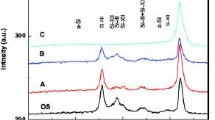Abstract
The effect of magnetic field on the nanohardness of monocrystalline silicon doped with phosphorous by ion implantation is studied. It is found that a magnetic field of certain parameters can increase the nanohardness of monocrystalline silicon doped with phosphorous by ion implantation, and this increase can be eliminated by annealing monocrystalline silicon doped with phosphorous by ion implantation at 800°C for 780 s. For the monocrystalline silicon doped with phosphorous by ion implantations that have not been exposed to a magnetic field, annealing them at 800°C for 780 s cannot affect their nanohardness, but exposing them to the magnetic field mentioned previously can no longer affect their nanohardness after annealing. The mechanism of all these phenomena is discussed. A possible mechanism that a magnetic field can promote the disbanding of vacancy clusters, and a possible mechanism of magnetically stimulated clusters’ disbanding and magnetoplastic effect are put forward.
Similar content being viewed by others
References
Yu. I. Golovin and R. B. Morgunov, J. Exp. Theor. Phys. 88, 332 (1999).
V. I. Al’shitz, E. V. Darinskaya, and O. L. Kazakova, J. Exp. Theor. Phys. 84, 338 (1997).
Yu. I. Golovin, R. B. Morgunov, D. V. Lopatin, A. A. Baskakov, and Y. E. Evgen’ev, Phys. Solid State 40, 1870 (1998).
Yu. I. Golovin, R. B. Morgunov, and V. E. Ivanov, Phys. Solid State 39, 550 (1997).
V. I. Al’shits, E. V. Darinskaya, and O. L. Kazakova, Phys. Solid State 40, 70 (1998).
E. V. Darinskaya, E. A. Petrzhik, S. A. Erofeev, and V. P. Kisel’, JETP Lett. 70, 309 (1999).
Yu. I. Golovin, Crystallogr. Rep. 49, 668 (2004).
A. M. Orlov, A. A. Skvortsov, and L. I. Gonchar, Phys. Solid State 43, 1252 (2001).
L. Junwan and Y. Ni, Rare Met. Mater. Eng. 39, 2095 (2010).
J. Jin, S. A. Shevlin, and Z. X. Guo, Acta Mater. 56, 4358 (2008).
J. Li, Y. Ni, Y. Lin, C. Luo, and W. Jiang, Acta Metall. Sin. 45, 129 (2009).
Ž. Pastuovic, I. Capan, R. Siegele, R. Jacimovic, J. Forneris, D. D. Cohen, and E. Vittone, Nucl. Instrum. Methods Phys. Res. 332, 298 (2014).
Yu. I. Golovin, A. A. Dmitrievskii, N. Y. Suchkova, and M. V. Badylevich, Phys. Solid State 47, 1278 (2005).
Yu. I. Golovin, A. A. Dmitrievskii, and N. Y. Suchkova, Phys. Solid State 48, 279 (2006).
V. S. Vavilov, V. F. Kiselev, and B. N. Mukashev, Defects in the Bulk and at the Surface of Silicon (Nauka, Moscow, 1990) [in Russian].
N. V. Kuznetsov and G. G. Solov’ev, Radiation Resistance of Silicon (Energoatomizdat, Moscow, 1989) [in Russian].
Yu. I. Golovin, A. A. Dmitrievskii, V. E. Ivanov, N. Y. Suchkova, and M. Y. Tolotaev, Phys. Solid State 49, 865 (2007).
A. L. Buchachenko, J. Exp. Theor. Phys. 105, 593 (2007).
R. B. Morgunov and A. L. Buchachenko, J. Exp. Theor. Phys. 109, 434 (2009).
Author information
Authors and Affiliations
Corresponding author
Additional information
The article is published in the original.
Rights and permissions
About this article
Cite this article
Zhang, X., Cai, Z.P. Effect of Magnetic Field on the Nanohardness of Monocrystalline Silicon and Its Mechanism. Jetp Lett. 108, 23–29 (2018). https://doi.org/10.1134/S0021364018130040
Received:
Accepted:
Published:
Issue Date:
DOI: https://doi.org/10.1134/S0021364018130040



